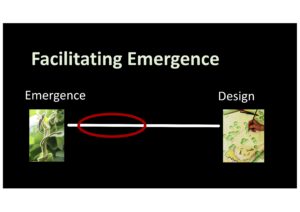Letting things Happen without Letting Go
„The focus of organisational change interventions moves away from ‘planning change’ and onto ‘facilitating emergence’. If we are looking to help a new paradigm emerge we need a new way to think about the role of the change agent—whether external consultant or internal OD specialist. We need a new metaphor“ (Richard Seel)

In the years of practicing and teaching organisation development I have come to accept that very few cases in my consulting practice can serve as textbook examples of a development process – mostly things happen in a way that is far from the book and far from what would be classically considered best practice. While this used to annoy me, I am actually starting to appreciate it.
Organisation Development is defined as a planned process of systemic change. In contrast to this, most change in organisations occurs as an emergent pattern resulting from complex interactions between actors. In many cases, these same actors (along with their OD consultants) get frustrated because the emergent change they experience does not reflect the change they designed. The answer to this challenge that I find most helpful is: Don’t fight emergence, the system has a pretty good idea, what it’s doing! But-And-Also: Don’t blindly trust it as something wonderful, just because it’s organic. Every emergent process can do with a little bit of love and care. This is the stance of facilitating emergence.
Emergence Defined
The concept of emergence was first coined by the English Philosopher George Henry Lewes almost 150 years ago. It describes properties of a system that cannot be predicted from the properties of its parts (thus are not purely additive or „resultant“). Examples of this are the interplay of ants creating an ant colony, the interplay of brain-cells creating consciousness or the interplay of engaged people and initiatives creating a social movement. In a beautifully simple way, emergence can be defined as “order arising out of chaos” (Holman, 2010, p. 18). This dynamic is not a one-way affair: The patterns that emerge in the larger system feed back down to influence the interactions and relationships on its parts. In complex adaptive systems (such as organisations) this feedback loop is a constant process. 
Quite a bit has been said about both extreme points of the emergence-design-continuum: the highly controlled pure design as well as the hands off emergence paradigm have been well described and advocated for, both in management and economic theory. Throughout the past decades, management literature has explored opening up the design side to let in some fresh air. First inspired by the humanistic ethics-effectiveness arguments, more recently lured by the fascinating accounts of complex adaptive systems and self-organisation, management and consulting practitioners have continuously loosened the rigid design and control paradigm to explore the semi-open space: participatory management, incremental strategy, responsive organisational structures and routines are just a few examples.
In most of these developments the design side has remained the practical reference point and openness is defined by its distance from the „100% control“ end of the continuum. Emergence in contrast shines up as an archetype, sometimes glorified as a promised land sometimes condemned or feared as anarchic chaos or neoliberal Darwinism. And indeed, emergence does not always deliver the best results: A garden grows over. Markets fail. The strong eat the weak. The Tragedy of the Commons, the Tyranny of Structurelessnes and The Iron Law of Oligarchy are are just a few of the challenges of unregulated social systems that call for answers. Tried and tested semi-emergent approaches are hard to come by as the space a little left center remains an uncomfortable spot.
If we accept that emergence is happening at all times and that it is equally promising and problematic, we need to explore ways to facilitate healthy emergence. I refer to these approaches as „3/4 openness“, pointing to the fact that their main emphasis is on letting things emerge while a small part is about design and guidance.
States of Emergent Change
Social Change theory makes a distinction between emergent, projectable and transformative change. Emergent change denotes the continuous developments that result from a system’s internal dynamics, either in reaction to an outside stimulus or driven by its inner forces. Projectable change in contrast is effected by an intentional process based on a comparison of actual and desired states. It can be compared to a problem solving process reforming individual subsystems. In the organizational learning theory projectable change is associated with “single loop learning”. Finally, transformative change is more like a revolution – an effort to change the game entirely, often as a response to severe crisis. This revolution first and foremost requires unlearning. In the organisational learning jargon this condition is called “double loop learning”.
Let us challenge the notion that these three types form a continuum in which emergent change is small and gradual and requires a hands off approach from leaders and consultants while transformative change requires powerful interventions. Let us explore the possibility that facilitating emergent change can in fact result in system transformations that are not only profound but also holistic and sustainable.
Emergent Change is not only continuous but also cumulative. Weick described it as “the realization of a new pattern of organizing in the absence of explicit a priori intentions”[1]. Reeler[2] differentiates less conscious and more conscious types of emergent change. The less conscious type can be found in early formation stages of a system and within shifting and uncertain environments. It is characterized by unformed and unclear identities, relationships, structures or leadership. Self-organisation and self-regulation are very weak under this condition. More conscious emergent change in turn occurs when identity, relationships, structures and (shared) leadership are more established. This is facilitated by more stable and less contradictory environments. It can be described as a „healthy self-regulation“.


Supporting an organisation to move from a less to a more conscious state of emergent change is a key challenge for self organisation development.
Another key challenge is keeping the ground soft: if we assume that emergence has a value, we need to figure out how we can fight path dependence in social systems.
[1] (as cited in Beer & Nohria, 2000, p. 226).
[2] A Theory of Social Change, Doug Reeler (2007)

